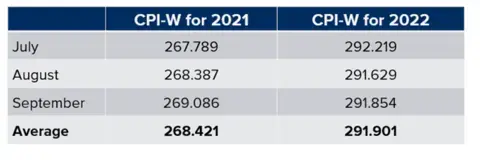To keep up with inflation and protect retirees' spending power. On October 13, 2022, the Social Security Administration (SSA) announced that the latest cost of living adjustment (COLA) is 8.7%, beginning with the December 2022 benefits, payable in January 2023. This amounts to an extra $147 per month for the average retired worker.
How COLAs Are Calculated
If Social Security benefits weren't adjusted, recipients would find out that their checks bought fewer goods and services each year. For example, the dollar’s value declined by about a third from 2000 to 2020. Without a COLA, someone who began collecting benefits in 2000 would only be able to buy nearly two-thirds as much with their help in 2020.
When the SSA calculates the annual COLA figure, they use the Consumer Price Index for Urban Wage Earners and Clerical Workers (CPI-W). CPI-W looks at a basket of goods and services purchased for consumption, including:
- Food and beverages
- Housing
- Apparel
- Transportation
- Medical care
- Recreation
- Education and communication
- Other goods and services (e.g., tobacco, personal services, etc.)
The COLA is calculated by comparing the average CPI-W for the current year's third quarter to the same period last year. As shown in the table below, the average CPI-W for the third quarter of 2022 was higher than the average of the third quarter of 2021 by 8.7% (rounded to the nearest one-tenth), resulting in an 8.7% COLA increase.
Figure 1: CPI-W Comparing Q3 2021 to Q3 2022

Source: Social Security Administration
Interestingly, as a retiree, the CPI-W is unlikely to represent how your spending habits change yearly accurately. That's because the CPI-W does a poor job of reflecting how vital health care costs are for retirees. While inflation remained relatively low (around 2%) until the skyrocketing rates of 2021 and 2022, the rate at which health care costs have increased far outpaces standard inflation. This includes nearly everything associated with health care, from doctor/hospital visits to long-term care and prescription drug costs. This means your expenses may be increasing at a much higher rate than what the CPI-W represents.
How COLA Affects Your Benefits
Even though the COLA was announced as 8.7%, that doesn’t translate to a direct 8.7% raise in your benefits. That’s because the COLA is applied to your primary insurance amount (PIA), which is then factored into the more significant benefits formula. Calculating your PIA and your resulting benefit amounts can be complicated. Still, the SSA has calculators and worksheets to help you get an idea of what your benefit amount will be.
While this year’s COLA increase is much higher than last year’s, it’s still worth noting that these adjustments can swing significantly from year to year. There’s always the potential for a year with an abnormally low COLA. For example, those receiving Social Security benefits saw only a 0.3% rise in 2017, while the COLA for 2016 was 0%, meaning benefits remained flat.
This underscores why having a comprehensive financial plan is so important: You don’t want to be so reliant on one source of income because your lifestyle would change if that source were to underdeliver. To better protect yourself from a year with a low—or nonexistent—COLA, consider these three takeaways:
1. Reduce Reliance on Social Security
While you've paid into this system your entire life and will likely provide a steady income source for years to come, it shouldn’t be your only source of income. Your retirement income plan should include Social Security, personal investment returns, and any potential pension/payout from your employer-sponsored retirement accounts. On top of that, you should have a specific plan for withdrawing income from these sources in a tax-efficient manner.
2. Consider Investing in a Health Savings Account
Healthcare costs are likely to continue growing at a faster rate than general inflation. Saving money in this arena is critical. If you're under age 65 and covered under a high-deductible health insurance plan, you may be eligible for pre-tax contributions to a Health Savings Account (HSA). Earnings inside an HSA grow tax-free, as long as distributions are used for qualified health care costs—which could save you a bundle in the long run.
3. Look into Long-Term Care Insurance
Long-term care (LTC) can be much more expensive than you would think, and although most people will need some sort of LTC in their lifetime, Medicare only pays for a small portion of it. The rest will have to be paid out-of-pocket—unless you have LTC insurance. Without it, you can imagine how quickly you may deplete your retirement nest egg.
Plan Ahead for COLA Changes
SSA will announce the next COLA in October 2023, when your PIA will be recalculated, and you'll see another change in your total benefit amount. If you have any questions about how these changes may impact your financial plan, please get in touch with your financial advisor.
The opinions voiced in this article are for general information only and are not intended to provide specific advice or recommendations for any individual.

